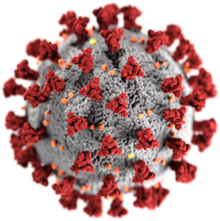Tammes problem
In mathematics, the Tammes problem describes the arrangement of non-overlapping circles on the unit sphere . It is named after the botanist PML Tammes , who examined the distribution of round pores on pollen grains in his dissertation in 1930 .
In the Tammes problem, the minimum distance between the circles on the sphere should be maximum. This packing problem is therefore an optimization problem in discrete geometry . The problem is solved for a small number of circles ( N ≤ 14). The problem is also solved for some highly symmetrical cases ( N = 12, 24, 48, 60, 120). Important work in this area comes from László Fejes Tóth .
Applications
A simple explanation for the arrangement of ligands in complex chemistry is the VSEPR model . The ligands are viewed as hard spheres that are arranged around the central atom and repel one another. This repulsion maximizes the distance between the balls. The result of the VSEPR model therefore agrees with the solution of the Tammes problem.
A similar question arises with the formation of micelles from long-chain molecules. Here, too, the geometry can be derived from the Tammes problem.
In five-coordinate metal complexes (PF 5 , Fe (CO) 5 etc.) the Berry pseudorotation describes the dynamic exchange of axial and equatorial ligands. This process is also related to the Tammes problem.
In biology, the Tammes problem helps describe self-assembly in spherical viruses ( tobacco mosaic virus , SARS-CoV-2 , etc.).
See also
Individual evidence
- ^ EA Lord, AL Mackay, S. Ranganathan: New Geometries for New Materials . 1st edition. Cambridge University Press, Cambridge 2006, ISBN 0-521-86104-7 , pp. 68-73 .
- ^ PML Tammes: On the number and arrangements of the places of exit on the surface of pollen-grains . In: Recueil des travaux botaniques néerlandais . tape 27 , no. 1 , 1930, p. 1-84 ( [1] ).
- ↑ L. Fejes Tóth: Regular Figures . 1st edition. Macmillan, New York 1964.
- ↑ LL Fejes Tóth: Bearings in the plane on the sphere and in space . 1st edition. Springer, Berlin 1953.
- ^ G. Fleck: Form, Function, and Functioning . In: M. Senechal (Ed.): Shaping Space. Exploring Polyhedra in Nature, Art, and the Geometrical Imagination . Springer, New York 2013, ISBN 978-0-387-92713-8 , pp. 171-189 .
- ↑ S. Fujii, S. Yamada, S. Matsumoto, et al .: Platonic Micelles: Monodisperse Micelles with Discrete Aggregation Numbers Corresponding to Regular Polyhedra. In: Sci Rep . tape 7 , 2017, p. 44494 , doi : 10.1038 / srep44494 .
- ↑ PW Fowler, T. Tarnai: Transition from spherical circle packing to covering: geometrical analogues of chemical isomerization . In: Proc. R. Soc. Lond. A. Band 452 , 1996, pp. 2043-2064 , doi : 10.1098 / rspa.1996.0108 .
- ^ AP Goucher: Molecular Geometry
- ↑ Aaron Klug : Molecular structure: Architectural design of spherical viruses . In: Nature . tape 303 , 1983, pp. 378-379 , doi : 10.1038 / 303378a0 .

